Why is employee wellbeing important in healthcare?
Employee wellbeing is important for healthcare workers. When employees experience wellbeing they can work well, putting all their energy into fulfilling key objectives.
Wellbeing affects employees’ job performance. Nursing is a demanding profession, and nurses must have their needs fulfilled to be able to care properly for others. Having an employee wellbeing program in your facility helps ensure that those needs are met and will positively impact the quality of your patient care.
Employee wellness challenges for nurses:
- Nurses deal directly with patients who may be impatient or irritable due to their discomfort.
- Nurses work long shifts performing multiple tasks, often under time pressure.
- Nurses face mental health challenges frequently, for example, due to patient suffering or stress from colleagues.
- Nurses draw on their inner reserves of resilience and creativity to give to others, and become depleted and burnt out as a result.
- Nurses interface between doctors and patients, investing much effort in communication.
- Nurses often have to put aside personal feelings to perform their job. Exercising emotional control drains emotional stamina.
- Often, nurses work without taking breaks while trying to satisfy patient needs and stay on top of administrative tasks.
Employee Wellness Programs Benefits
For those reasons, nursing is much more demanding than other jobs, with potentially higher stress levels. The best way for a nurse to have the emotional stamina for all of this is by drawing strength from workplace wellbeing initiatives.
An emotionally strong nurse can support colleagues, patients, and even superiors. When managers support their nurses with wellbeing programs, nurses will develop meaningful friendships in the workplace and invest in their own career wellbeing. Most importantly, managers who invest in nurses’ wellbeing will help them experience lower psychological work-related distress.
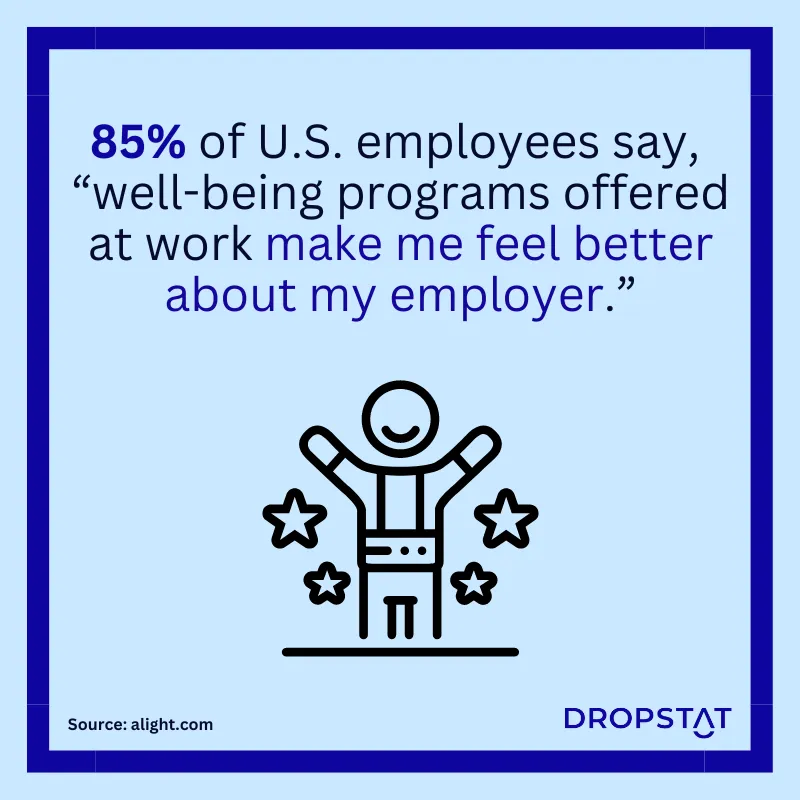
The benefits for employers of employee wellness programs
In many organizations, programs for employee health and wellbeing contribute to company culture and provide a direct advantage to the employer. Statistics show that wellness programs boost employee attendance, reducing absences by approximately 15%. Employees who participated in employee wellness programs reported up to 56% fewer sick days.
What is an employee wellness program?
Wellbeing and wellness go hand in hand. What is the difference between wellbeing and wellness? Wellness is practicing healthy habits. An employee wellness program is one aspect of employee wellbeing. The focus is on improving employees’ physical health and fitness. Wellness programs may include free gym memberships, healthy food vouchers, discounts, and rewards for making health-conscious choices. Employee wellness programs are usually either directly from the employer or through the health insurance provider.
What are employee wellbeing initiatives?
Employee wellbeing is the overall experience of being in a positive work atmosphere. Employee wellbeing initiatives are the plans, services, and offers presented by or through the employer for employees.
These include:
Health insurance plans
These put the employee’s health worries at ease. This is especially relevant in today’s tight labor market, where more employees expect employers to include health insurance in basic benefits packages. Employers should ensure employees have healthcare plans and know how to access their benefits.
Mental health services
When employees can air out their worries, they are free to focus on work objectives when they are at work. They will have fewer mental health absences. Poor mental health in employees leads to employees who complain, are uncooperative, and provide lower patient quality care.
Paid time for family responsibilities
This builds a company culture where the employees feel accepted and valued as members of the staff. Getting closer to a healthy work-life balance leads to higher employee morale. The result is employees who are dedicated to the facility in which they work.
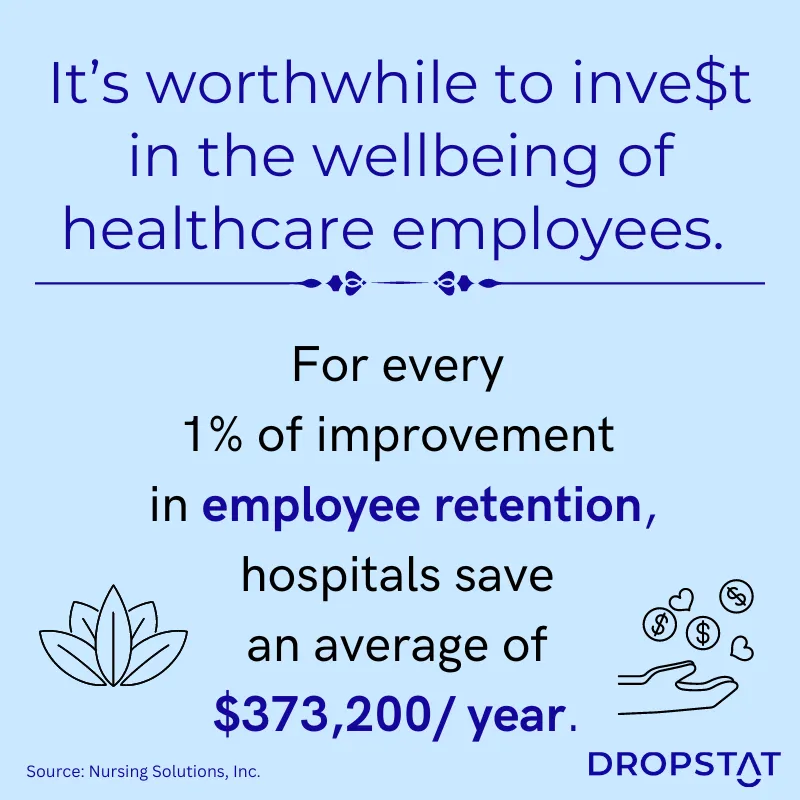
Employee financial wellness programs
It’s not enough to pay employees on time. Employees expect sufficient wages and advice on money management. Once financial distraction is off the board, employee engagement follows. Research shows that 45% of employees lose focus at work due to worry about financial stressors. Things are changing, with 24% of employees reporting that their employers help them with personal finances. Additionally, research suggests that employers who don’t offer these benefits will face employee retention challenges and employee burnout. On the other hand, retirement plan benefits and financial assistance encourage employees to stay at their place of employment instead of looking for a new job.
Physical wellbeing programs
Employers can encourage employee wellbeing by giving paid time for physical health activities as part of an employee wellness plan. Having a walk in the fresh air can turn an employee’s day around entirely. A refreshed employee is 40% more productive. Healthy and refreshed nurses will be happier and more cooperative.
Community wellbeing strategy
The facility should cultivate a sense of community among employees. Setting up the framework for a supportive nursing community with opportunities for nurses to contribute to each other builds employee morale and productivity.
Yoga classes
Yoga – the new panacea – can contribute to happiness and reduce depression for all participating employees. Yoga promotes health and wellbeing and has a documented track record for increasing employee engagement, job satisfaction, and work performance. Happy nurses are productive and provide better patient care and safer staffing.
Flexible work hours
One of the mental health benefits many employees seek is a healthy work-life balance. Nurses often suffer from long hours and inflexibility in shift control. Giving nurses greater flexibility in shift management would contribute significantly to nurses’ work-life balance and reduce stress levels. For example, with shift flexibility, nurses can take time off for a child’s school performance. Of course, they would make up the shift later.
The Impact of employee wellbeing on patient care
Both the employer and employee gain from increasing worker wellbeing with wellbeing initiatives and employee health and wellness programs.
Apart from employee motivation, employee wellness ideas boost the nurse-patient relationship. For patients, nurse wellbeing may directly define their patient experience. If a bedside nurse smiles because of feeling relaxed and fulfilled, it could lift the mood of their patients. Better quality patient care and safer staffing are proven outcomes of a successful employee wellbeing program.
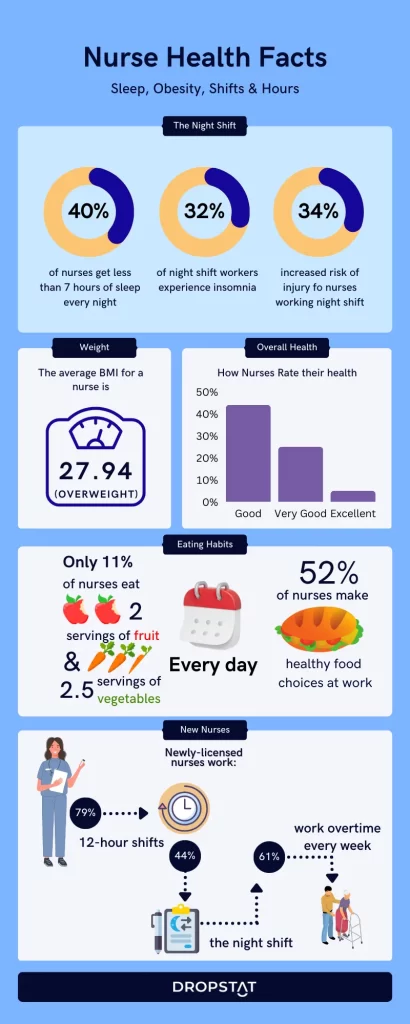
What are the pillars of employee wellbeing?
Researchers suggest different factors that contribute to employee wellbeing. Some nurses are very present – such as CNAs, bedside nurses, or emergency room nurses. Their employee-wellbeing needs might differ from those of a nurse practitioner (NP), who is often located in a medical office. Telehealth nurses (remote working) are distant from their patients and may need different elements of wellbeing.
The best employee wellness programs empower nurses to succeed by upholding the main ‘pillars’ of employee wellbeing. Gallup set 5 “universal elements” of employee wellbeing, which apply to every employee:
Career wellbeing:
A person enjoys what they do at work daily.
Social wellbeing:
Meaningful friendships enrich their life.
Financial wellbeing:
Their financial health is good because they successfully manage their personal finances.
Physical wellbeing:
They enjoy good physical health.
Community wellbeing:
They enjoy the environment where they live.
Of these 5, career wellbeing has the most influence.
Other researchers add meaning, fulfillment, mental health, productivity, autonomy, safety, and an inclusionary culture to desirable workplace attributes.
The way to ensure the workforce thrives is by developing employee wellness programs to foster a positive working environment. Wellness programs promote wellbeing in nurses and satisfy nurses’ needs which helps develop a positive employee experience.
The fact is that employee wellbeing has a positive effect on the bottom line – productivity and profitability. When healthcare employees feel their best, they can access their strengths and contribute to the facility’s goals.
How can you measure employee wellbeing?
The first step in improving employee wellbeing in a facility is to measure current levels of employee wellbeing across the organization. Here’s how to do that.
Begin by looking at where the company culture has taken your workers so far.
Do employees feel confident in their tasks? Are they afraid of making mistakes? Do they feel they have someone to talk to? If you are already providing gifts, bonuses, or other benefits, do your employees value them? Do they connect the gifts or bonuses to wellbeing at work? Do employees have suggestions for changes at work or to the benefits system? And, of course, can employees express their feelings or opinions without fear of backlash?
Look at your company goals. How can adjusting your employee wellbeing strategy help you achieve your goals?
Set employee wellbeing goals.
Set a timeframe for achieving those goals and measuring company success.
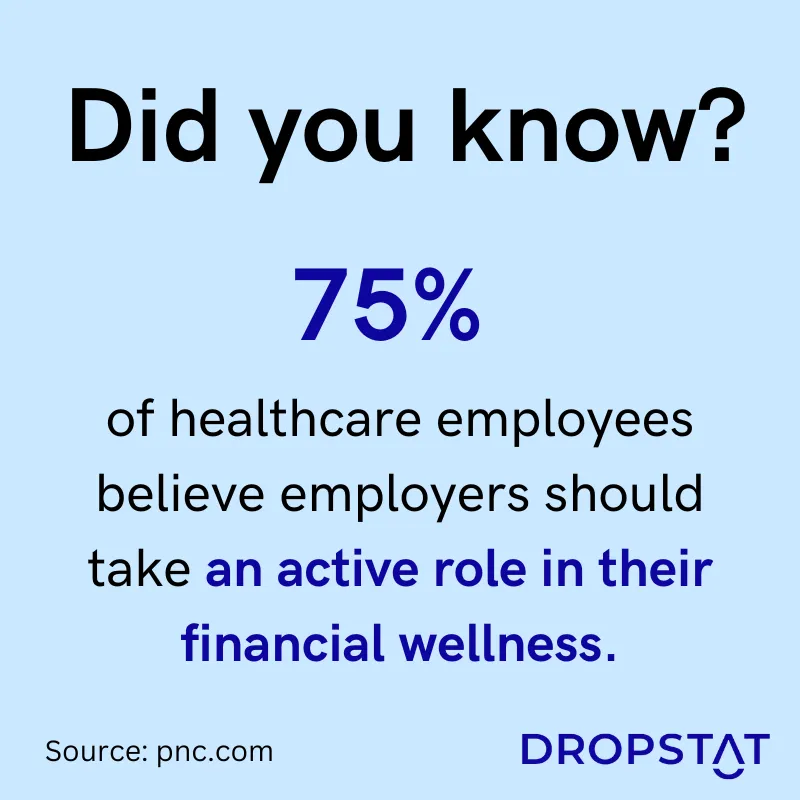
Now you are ready to measure employee wellbeing. Choose one or more of these methods of assessment:
- Conduct pulse surveys (a brief set of questions sent to employees regularly). Make sure to always ask the same questions. You can choose open-ended questions (for free-form answers) or closed-ended questions (with yes/no/improving answers). Each employee wellness survey should be focused on one topic.
- Analyze workforce data – absenteeism, being present but unable to work to maximum ability, days when all staff members are present and the atmosphere when that happens, and units/department-specific data that may indicate success or problematic issues.
- Senior leaders should meet with advisors to discuss and assess feedback and work patterns that the manager might not have noticed.
Reassess employee wellbeing after the set time has passed. Did your employees manage to get on board? Did the wellbeing program have a positive effect on them?
Tips for improving employee wellbeing in healthcare
Here are some great tips for improving employee wellbeing in your facility.
- Career advancement – discuss career development. Employers should show employees they believe in them and support their career-related and financial goals for the future.
- Encourage nurse managers to mentor nurses. Nurses should enjoy meaningful positive feedback.
- Workers should have a way to report abusive managers to their superiors. Every worker has a right to be happy to come to work.
- Have open channels for communication. Conducting staff surveys is an excellent means of keeping a finger on the pulse in every unit. Measuring nurse job satisfaction as frequently as after every shift would be the ideal way to track staff needs as changes take place.
- Employee engagement and wellbeing are interdependent. Employees should be encouraged to use their innate strengths, which increases their involvement in the facility, and their enthusiasm for the job at hand. The message of “I value you for who you are” should be overt.
- Employee retention is improved when managers support DEI (diversity, equity, and inclusion) – especially as it applies to work-life balance for employees who are parents or are separated, or who are otherwise at a disadvantage.
- Encourage a sense of belonging among employees to boost motivation and wellbeing at work. Some employers ask, “Would you recommend a friend to come and work here?” While it is not always an easy question to answer, it is definitely a good indicator of employee satisfaction.
- Nurses who can respectfully air their feelings make up a thriving workforce. Managers should have time slots to listen to staff and understand their issues and allow for open communication.
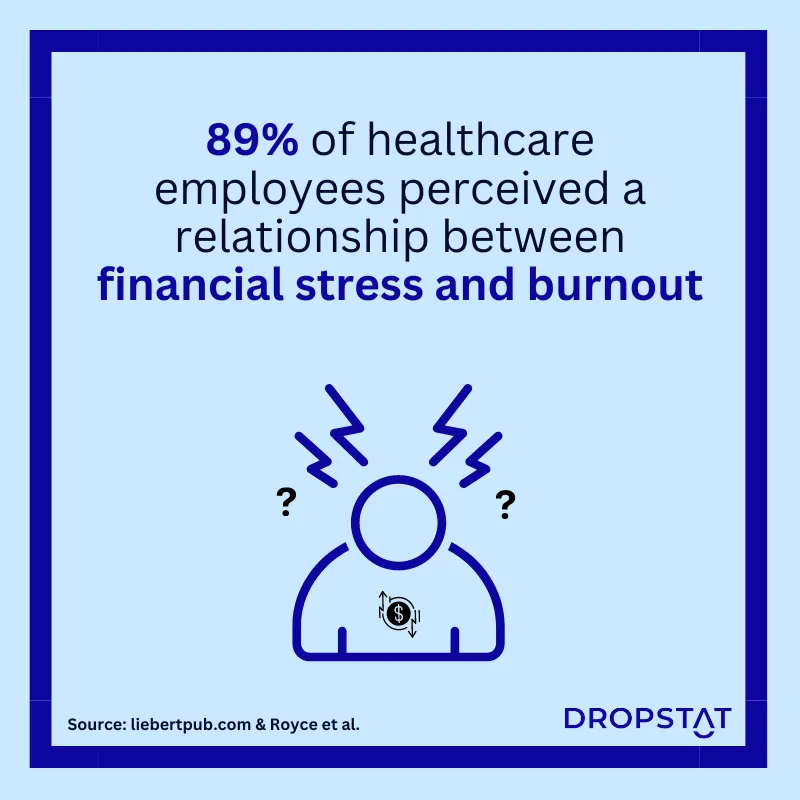
How Dropstat helps you improve employee wellbeing
Dropstat is the first staffing management solution designed for healthcare. Dropstat’s many wellbeing features work to combat employee wellbeing challenges and improve employee wellness in healthcare. Dropstat’s encrypted chat encourages communication between staff members and easily notifies staff of events, which helps maintain staff engagement levels. Dropstat’s gratitude feed injects a positive element into employees’ days as they express gratitude to each other for favors received and when they notice good news in their own lives. Wellbeing boosts employee morale and project management with noticeably improved levels of employee cooperation.
Wellbeing at work is especially important in healthcare. Dropstat promotes safety and mental wellness, making it easy for nurses to reach out and talk to therapists through the app. Additionally, employees can rate their satisfaction with emojis after each shift which helps managers assess and stay updated on employee wellbeing. Dropstat helps improve the quality of the employee experience to create and retain an engaged, thriving workforce. Schedule a demo to see how improving employee wellbeing can revive the workforce in your facility.
FAQs for Employee Wellbeing:
How many U.S. companies offered employee wellness plans in 2022?
52% of companies in America offered wellness programs. Of these, the most popular initiatives were: onsite flu vaccine (52%), general wellness (52%), and stopping smoking (34%). Other initiatives were weight loss (25%), stress management (25%), preventative health (22%), personal coaching (21%), and meditation (18%).
Do employee wellbeing programs really matter to healthcare employers?
87% of job candidates rate health and wellness benefits when looking for a job. And employers who engage in employee wellness enjoy that 85% of employees say they intend to stay at their jobs. Maybe because of this, employers who provide wellness programs gain a 6-to-1 return on investment (the company earns $6 for each $1 spent on employee wellbeing) through lower employee healthcare expenses, lower absenteeism and higher employee productivity and performance. These are really important factors in the healthcare industry, which is plagued by high employee turnover rates and staffing shift gaps caused by high absenteeism.







